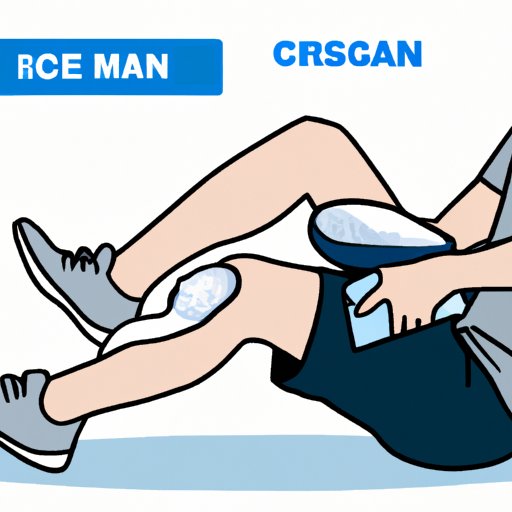Introduction
Shin pain is an incredibly common problem, particularly amongst runners and athletes who are frequently engaging in high-intensity exercise. However, it’s possible to experience shin pain even if you’re not exercising. In this article, we’ll explore the various causes and treatments of shin pain without exercise.
Definition of Shin Pain
Shin pain is any type of discomfort or pain felt along the front of your lower leg. It can range from a dull ache to a sharp, stabbing sensation. The area affected may also be tender to the touch. Shin pain can occur suddenly or gradually, depending on the underlying cause.
Overview of Common Causes
Shin pain can be caused by many different issues. Some of the most common include:
- Overuse injuries
- Stress fractures
- Compartment syndrome
- Shin splints

Examining Common Causes of Shin Pain Without Exercise
Let’s take a closer look at the most common causes of shin pain without exercise.
Overuse Injuries
Overuse injuries refer to any type of injury that occurs due to repetitive use or strain. These types of injuries often occur when a person participates in the same activity for extended periods of time without adequate rest. Examples of overuse injuries that can cause shin pain include tendinitis, bursitis, and periostitis.
Stress Fractures
Stress fractures are tiny cracks in the bone caused by repeated stress and strain. They usually occur when a person increases their level of physical activity too quickly. Stress fractures can cause severe pain in the shin and may require medical intervention.
Compartment Syndrome
Compartment syndrome is a condition in which the pressure within the muscles of the lower leg rises to dangerous levels. This increased pressure can cause pain, swelling, and numbness in the affected area. Compartment syndrome is a serious condition that requires immediate medical attention.
How to Treat Shin Pain Without Exercise
If you’re experiencing shin pain without exercise, there are several things you can do to reduce your discomfort.
Rest and Ice Therapy
Resting and applying ice to the affected area can help reduce inflammation and pain. Make sure to give yourself plenty of time to rest and avoid activities that could further aggravate your shin pain.
Anti-inflammatory Medications
Over-the-counter anti-inflammatory medications such as ibuprofen and naproxen sodium can help reduce pain and swelling. Be sure to follow the instructions on the package and talk to your doctor before taking any medication.
Physical Therapy
Physical therapy can help strengthen the muscles and tissues in the lower leg, which can reduce pain and improve mobility. Your physical therapist can also teach you exercises and stretches to help you manage your shin pain.
Coping With Shin Pain When You’re Not Exercising
If you’re not able to exercise due to shin pain, there are still ways to stay active without further aggravating your injury.
Low-Impact Activities
Low-impact activities such as swimming, walking, and cycling can provide a great way to stay fit without putting too much strain on your shins. Make sure to start slowly and gradually increase your intensity as your shin pain improves.
Stretching and Strengthening Exercises
Gentle stretching and strengthening exercises can help improve flexibility and reduce pain. Talk to your doctor or physical therapist about specific exercises that can help with your shin pain.
Wearing Proper Footwear
Wearing proper shoes with good arch support can help reduce the strain on your shins. Make sure to replace your shoes regularly to ensure they are providing adequate cushioning and support.

Understanding Shin Splints: What Causes Them and How to Treat Them Without Exercise
Shin splints are a common cause of shin pain. They occur when the muscles and tendons in the lower leg become inflamed due to overuse or strain. Let’s take a look at the causes of shin splints and how to treat them without exercise.
Causes of Shin Splints
Shin splints are caused by excessive strain on the muscles and tendons in the lower leg. This can occur from running, walking, or jumping on hard surfaces, wearing improper footwear, or any other activities that put a lot of stress on the legs.
Treatments for Shin Splints
Treating shin splints without exercise involves rest, ice therapy, anti-inflammatory medications, and physical therapy. Make sure to talk to your doctor or physical therapist about the best way to manage your shin splints.

The Role of Rest in Relieving Shin Pain Without Exercise
Getting enough rest is essential for relieving shin pain without exercise. When you rest, your body has a chance to repair itself and heal any underlying conditions that may be causing your pain.
Benefits of Rest
Resting gives your body a chance to recover and repair itself. It also reduces inflammation and pain, allowing you to move more freely. Additionally, getting enough rest can help you avoid getting injured again in the future.
Tips for Getting Enough Rest
To ensure you’re getting enough rest, set aside some time each day to relax. Try to avoid strenuous activities during this time and focus on activities that help you relax and unwind. Additionally, make sure to get plenty of sleep each night to give your body the rest it needs.
Conclusion
Shin pain can be a debilitating condition, but it is possible to manage it without exercise. Understanding the causes and treatments of shin pain without exercise can help you find relief from your symptoms. Remember to rest, apply ice, take anti-inflammatory medications, and engage in physical therapy as needed. With the right treatment plan, you can find relief from your shin pain and get back to living a healthy and active life.


